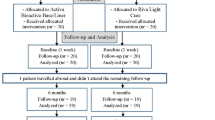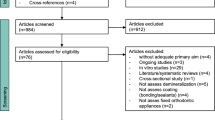Abstract
Objective White spot lesions are characterised by the presence of clinically detectable opaque lesions due to enamel demineralisation. These frequently present in patients following fixed orthodontic treatment, mostly due to the prolonged accumulation of bacterial plaque on the dental surface. When remineralisation is not achieved through good oral hygiene and prophylaxis with fluoride products, the infiltration of lesions with low-viscosity photopolymerised resin has proved to be a valid micro-invasive alternative compared to traditional conservative therapy.
Clinical considerations A case series will be presented, where the chosen approach was resin infiltration, a micro-invasive and aesthetic technique.
Clinical significance Infiltrative resin therapies are single-session procedures that reduce the need for more invasive therapies such as the use of rotary instruments for greater patient comfort. The need for periodic fluoride applications is also avoided. This approach increases the durability of the infiltrated lesion without compromising its mechanical properties and impedes the development of recurrent or secondary caries.
Conclusions Resin infiltration might be considered as a routine procedure in the treatment of post-eruptive hypomineralised lesions. This follows the line of thought of minimally invasive dentistry, is an excellent treatment option and prevents the lesion's progression.
Key points
-
Patients under orthodontic treatment must follow strict preventive measures.
-
Early intervention with infiltrative resins can stop caries lesion progression.
-
Infiltrative resins allow achieving a good aesthetic result and are minimally invasive.
This is a preview of subscription content, access via your institution
Access options
Subscribe to this journal
Receive 24 print issues and online access
$259.00 per year
only $10.79 per issue
Buy this article
- Purchase on Springer Link
- Instant access to full article PDF
Prices may be subject to local taxes which are calculated during checkout










Similar content being viewed by others
References
Sundararaj D, Venkatachalapathy S, Tandon A, Pereira A. Critical evaluation of incidence and prevalence of white spot lesions during fixed orthodontic appliance treatment: A meta-analysis. J Int Soc Prev Community Dent 2015; 5: 433.
Guo L, Shi W. Salivary biomarkers for caries risk assessment. J Calif Dent Assoc 2013; 41: 107-109, 112-118.
Paula A B P, Fernandes A R, Coelho A S et al. Therapies for White Spot Lesions - A Systematic Review. J Evid Based Dent Pract 2017; 17: 23-38.
Abdullah Z, John J. Minimally Invasive Treatment of White Spot Lesions-A Systematic Review. Oral Health Prev Dent 2016; 14: 197-205.
Knösel M, Eckstein A, Helms H J. Durability of esthetic improvement following Icon resin infiltration of multibracket-induced white spot lesions compared with no therapy over 6 months: A single-centre, split-mouth, randomized clinical trial. Am J Orthod Dentofac Orthop 2013; 144: 86-96.
Chapman J A, Roberts W E, Eckert G J, Kula K S, González-Cabezas C. Risk factors for incidence and severity of white spot lesions during treatment with fixed orthodontic appliances. Am J Orthod Dentofac Orthop 2010; 138: 188-194.
Behrouzi P, Heshmat H, Hoorizad Ganjkar M, Tabatabaei S F, Kharazifard M J. Effect of Two Methods of Remineralization and Resin Infiltration on Surface Hardness of Artificially Induced Enamel Lesions. J Dent (Shiraz) 2020; 21: 12-17.
Tufekci E, Dixon J S, Gunsolley J C, Lindauer S J. Prevalence of white spot lesions during orthodontic treatment with fixed appliances. Angle Orthod 2011; 81: 206-210.
Benson P E, Parkin N, Dyer F, Millett D T, Furness S, Germain P. Fluorides for the prevention of early tooth decay (demineralised white lesions) during fixed brace treatment. Cochrane Database Syst Rev 2013; DOI: 10.1002/14651858.CD003809.pub3.
Yap J, Walsh L J, Naser-Ud Din S, Ngo H, Manton D J. Evaluation of a novel approach in the prevention of white spot lesions around orthodontic brackets. Aust Dent J 2014; 59: 70-80.
Morrier J-J. White spot lesions and orthodontic treatment. Prevention and treatment. Orthod Fr 2014; 85: 235-244.
Cazzolla A P, De Franco A R, Lacaita M, Lacarbonara V. Efficacy of 4-year treatment of icon infiltration resin on postorthodontic white spot lesions. BMJ Case Rep 2018; DOI: 10.1136/bcr-2018-225639.
Khoroushi M, Kachuie M. Prevention and treatment of white spot lesions in orthodontic patients. Contemp Clin Dent 2017; 8: 11-19.
Amaechi B T. Remineralisation - The buzzword for early MI caries management. Br Dent J 2017; 223: 173-182.
Gözetici B, Öztürk-Bozkurt F, Toz-Akalın T. Comparative Evaluation of Resin Infiltration and Remineralisation of Noncavitated Smooth Surface Caries Lesions: 6-month Results. Oral Health Prev Dent 2019; 17: 99-106.
Subramaniam P, Girish Babu K L, Lakhotia D. Evaluation of penetration depth of a commercially available resin infiltrate into artificially created enamel lesions: An in vitro study. J Conserv Dent 2014; 17: 146-149.
Laleman I, Detailleur V, Slot D E, Slomka V, Quirynen M, Teughels W. Probiotics reduce mutans streptococci counts in humans: A systematic review and meta-analysis. Clin Oral Investig 2014; 18: 1539-1552.
Tirali R E, Bodur H, Ece G. In vitro antimicrobial activity of Sodium hypochlorite, Chlorhexidine gluconate and Octenidine Dihydrochloride in elimination of microor-ganisms within dentinal tubules of primary and permanent teeth. Med Oral Patol Oral Cir Bucal 2012; DOI: 10.4317/medoral.17566.
Makinen K K, Pape H R, Makinen P L, Bennett C A, Isotupa K P, Isokangas P J. Xylitol Chewing Gums and Caries Rates: A 40-month Cohort Study. J Dent Res 1995; 74: 1904-1913.
Milgrom P, Söderling E M, Nelson S, Chi D L, Nakai Y. Clinical evidence for polyol efficacy. Adv Dent Res 2012; 24: 112-116.
Hu W, Featherstone J D B. Prevention of enamel demineralization: An in-vitro study using light-cured filled sealant. Am J Orthod Dentofac Orthop 2005; 128: 592-600.
O'Reilly M T, De Jesus Vinas J, Hatch J P. Effectiveness of a sealant compared with no sealant in preventing enamel demineralization in patients with fixed orthodontic appliances: a prospective clinical trial. Am J Orthod Dentofacial Orthop 2013; 143: 837-844.
de Freitas P M, Rapozo-Hilo M, Eduardo C de P, Featherstone J D B. In vitro evaluation of erbium, chromium: yttrium-scandium-gallium-garnet laser-treated enamel demineralization. Lasers Med Sci 2010; 25: 165-170.
Knösel M, Attin R, Becker K, Attin T. External bleaching effect on the colour and luminosity of inactive white-spot lesions after fixed orthodontic appliances. Angle Orthod 2007; 77: 646-652.
Bussadori S K, Do Rego M A, Da Silva P E, Pinto M M, Pinto A C G. Esthetic alternative for fluorosis blemishes with the usage of a dual bleaching system based on hydrogen peroxide at 35%. J Clin Pediatr Dent 2004; 28: 143-146.
Ardu S, Castioni N V, Benbachir N, Krejci I. Minimally invasive treatment of white spot enamel lesions. Quintessence Int 2007; 38: 633-636.
Donly K J, Sasa S I. Potential Remineralization of Postorthodontic Demineralized Enamel and the Use of Enamel Microabrasion and Bleaching for Esthetics. Semin Orthod 2008; 14: 220-225.
Jahanbin A, Ameri H, Shahabi M, Ghazi A. Management of Post-orthodontic White Spot Lesions and Subsequent Enamel Discoloration with Two Microabrasion Techniques. J Dent (Shiraz) 2015; 16: 56-60.
Ntovas P, Rahiotis C. A clinical guideline for caries infiltration of proximal enamel lesions with resins. Br Dent J 2018; 225: 299-304.
Enan E T, Aref N S, Hammad S M. Resistance of resin-infiltrated enamel to surface changes in response to acidic challenge. J Esthet Restor Dent 2019; 31: 353-358.
Muñoz M A, Arana-Gordillo L A, Gomes G M et al. Alternative esthetic management of fluorosis and hypoplasia stains: Blending effect obtained with resin infiltration techniques. J Esthet Restor Dent 2013; 25: 32-39.
Aziznezhad M, Alaghemand H, Shahande Z et al. Comparison of the effect of resin infiltrant, fluoride varnish, and nano-hydroxy apatite paste on surface hardness and streptococcus mutans adhesion to artificial enamel lesions. Electron Physician 2017; 9: 3934-3942.
Anand V, Arumugam S B, Manoharan V, Kumar S A, Methippara J J. Is Resin Infiltration a Microinvasive Approach to White Lesions of Calcified Tooth Structures?: A Systemic Review. Int J Clin Pediatr Dent 2019; 12: 53-58.
Cazzolla A P, De Franco A R, Lacaita M L V. Efficacy of 4-year treatment of icon infiltration resin on postorthodontic white spot lesions. BMJ Case Rep 2018; DOI: 10.1136/bcr-2018-225639.
Ekizer A, Zorba Y O, Uysal T, Ayrikcil S. Effects of demineralizaton-inhibition procedures on the bond strength of brackets bonded to demineralized enamel surface. Korean J Orthod 2012; 42: 17-22.
Mandava J, Reddy Y S, Kantheti S et al. Microhardness and Penetration of Artificial White Spot Lesions Treated with Resin or Colloidal Silica Infiltration. J Clin Diagn Res 2017; DOI: 10.7860/JCDR/2017/25512.9706.
Dorri M, Dunne S M, Walsh T, Schwendicke F. Micro-invasive interventions for managing proximal dental decay in primary and permanent teeth. Cochrane Database Syst Rev 2015; DOI: 10.1002/14651858.CD010431.pub2.
Elrashid A H, Alshaiji B S, Saleh S A, Zada K A, Baseer M A. Efficacy of Resin Infiltrate in Noncavitated Proximal Carious Lesions: A Systematic Review and Meta-Analysis. J Int Soc Prev Community Dent 2019; 9: 211-218.
Kielbassa A M, Muller J, Gernhardt C R. Closing the gap between oral hygiene and minimally invasive dentistry: a review on the resin infiltration technique of incipient (proximal) enamel lesions. Quintessence Int 2009; 40: 663-681.
Domejean S, Ducamp R, Léger S, Holmgren C. Resin infiltration of non-cavitated caries lesions: A systematic review. Med Princ Pract 2015; 24: 216-221.
Knosel M, Eckstein A, Helms H-J. Long-term follow-up of camouflage effects following resin infiltration of post orthodontic white-spot lesions in vivo. Angle Orthod 2019; 89: 33-39.
Borges A B, Caneppele T M F, Masterson D, Maia L C. Is resin infiltration an effective esthetic treatment for enamel development defects and white spot lesions? A systematic review. J Dent 2017; 56: 11-18.
Kielbassa A M, Leimer M R, Hartmann J, Harm S, Pasztorek M, Ulrich I B. Ex vivo investigation on internal tunnel approach/internal resin infiltration and external nanosilver-modified resin infiltration of proximal caries exceeding into dentin. PLoS One 2020; DOI: 10.1371/journal.pone.0228249.
Prasada K, Penta P, Ramya K. Spectrophotometric evaluation of white spot lesion treatment using novel resin infiltration material (Icon). J Conserv Dent 2018; 21: 531.
Gu X, Yang L, Yang D et al. Esthetic improvements of postorthodontic white-spot lesions treated with resin infiltration and microabrasion: A split-mouth, randomized clinical trial. Angle Orthod 2019; 89: 372-377.
Schnabl D, Dudasne-Orosz V, Glueckert R, Handschuh S, Kapferer-Seebacher I, Dumfahrt H. Testing the Clinical Applicability of Resin Infiltration of Developmental Enamel Hypomineralization Lesions Using an In Vitro Model. Int J Clin Pediatr Dent 2019; 12: 126-132.
Author information
Authors and Affiliations
Corresponding author
Ethics declarations
The authors declare no conflict of interests.
Rights and permissions
About this article
Cite this article
Tavares, M., Saraiva, J., do Vale, F. et al. Resin infiltration in white spot lesions caused by orthodontic hypomineralisation: a minimally invasive therapy. Br Dent J 231, 387–392 (2021). https://doi.org/10.1038/s41415-021-3476-z
Received:
Accepted:
Published:
Issue Date:
DOI: https://doi.org/10.1038/s41415-021-3476-z



